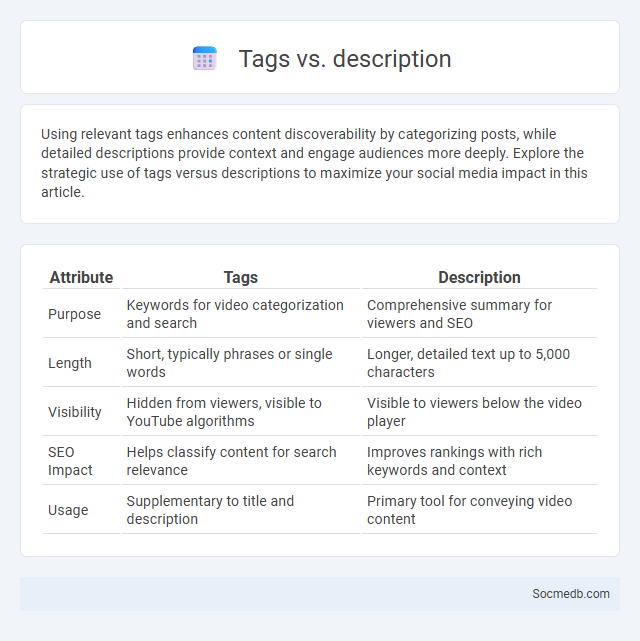
Photo illustration: tags vs description
Using relevant tags enhances content discoverability by categorizing posts, while detailed descriptions provide context and engage audiences more deeply. Explore the strategic use of tags versus descriptions to maximize your social media impact in this article.
Table of Comparison
| Attribute | Tags | Description |
|---|---|---|
| Purpose | Keywords for video categorization and search | Comprehensive summary for viewers and SEO |
| Length | Short, typically phrases or single words | Longer, detailed text up to 5,000 characters |
| Visibility | Hidden from viewers, visible to YouTube algorithms | Visible to viewers below the video player |
| SEO Impact | Helps classify content for search relevance | Improves rankings with rich keywords and context |
| Usage | Supplementary to title and description | Primary tool for conveying video content |
Understanding Tags, Descriptions, and Metadata
Tags, descriptions, and metadata play crucial roles in enhancing social media content visibility and engagement by improving searchability and categorization. Accurate tags associate posts with relevant topics, while detailed descriptions provide context that attracts target audiences. Metadata, such as timestamps and location data, further optimizes content discoverability across social media algorithms and platforms.
Key Differences Between Tags, Descriptions, and Metadata
Tags categorize content by keywords to improve discoverability on social media platforms, while descriptions provide a detailed summary or context that enhances user engagement and search engine results. Metadata encompasses technical information such as upload date, file type, and location data, enabling platforms to organize and filter content more effectively. Understanding these distinct elements helps optimize social media visibility and ensures content reaches the intended audience efficiently.
The Role of Tags in Content Organization
Tags play a crucial role in organizing content on social media by categorizing posts, enhancing discoverability, and connecting related topics. Proper use of tags allows Your content to reach targeted audiences, increasing engagement and visibility across platforms. Effective tagging strategies streamline content management and boost social media marketing performance.
How Descriptions Enhance Search Visibility
Descriptions on social media profiles and posts play a crucial role in enhancing search visibility by incorporating relevant keywords that align with what users are searching for. Optimized descriptions improve the chances of your content appearing in search engine results and platform-specific searches, driving more organic traffic and engagement. By crafting clear, keyword-rich descriptions, you ensure Your social media presence is more discoverable and attractive to both algorithms and potential followers.
What is Metadata? Functions and Benefits
Metadata in social media refers to the descriptive information embedded in posts, images, videos, and user profiles that helps categorize and organize content for better searchability and relevance. It functions by enabling platforms to understand context, user behavior, and content relationships, thereby improving personalized recommendations, targeted advertising, and data analytics. Your ability to leverage metadata enhances content visibility, engagement rates, and overall social media marketing effectiveness.
SEO Impact: Tags vs Description vs Metadata
Tags enhance social media SEO by categorizing content, making it discoverable through relevant keywords and trends. Descriptions provide context and incorporate strategic keywords to improve search engine rankings and engage users effectively. Metadata, including titles, alt text, and structured data, ensures better indexing by search engines, boosting visibility and driving organic traffic from social media platforms.
Best Practices for Tag Implementation
Effective tag implementation on social media enhances content discoverability and audience engagement by using relevant, specific hashtags aligned with your niche. Employ a mix of trending, branded, and community tags to maximize reach while avoiding over-tagging, which can appear spammy. You can boost your content's visibility and connect with targeted users by researching and consistently applying optimized tags tailored to your audience and platform algorithms.
Optimizing Descriptions for Higher Click-Through Rates
Crafting concise, keyword-rich social media descriptions significantly enhances visibility and click-through rates by aligning with platform algorithms and user search intent. Incorporating action-oriented language and relevant hashtags drives user engagement while emphasizing the value proposition encourages immediate interaction. Testing various description formats using A/B testing tools provides data-driven insights to continually refine content for maximum reach and impact.
Essential Metadata Elements for Better Indexing
Essential metadata elements for better indexing on social media include accurate hashtags, descriptive alt text, and comprehensive captions that boost content discoverability. Incorporating precise timestamps, geotags, and user tags further enhances search engine optimization and user engagement. Proper metadata structuring supports algorithmic relevance, improving content ranking and visibility across platforms.
Choosing the Right Strategy: Tags, Descriptions, or Metadata
Effective social media marketing hinges on choosing the right strategy--leveraging tags, descriptions, or metadata to enhance content visibility and engagement. Optimizing tags with relevant keywords improves searchability, while compelling descriptions increase click-through rates and audience interaction. Proper use of metadata ensures that platforms accurately categorize and recommend content, maximizing reach and relevance.
 socmedb.com
socmedb.com